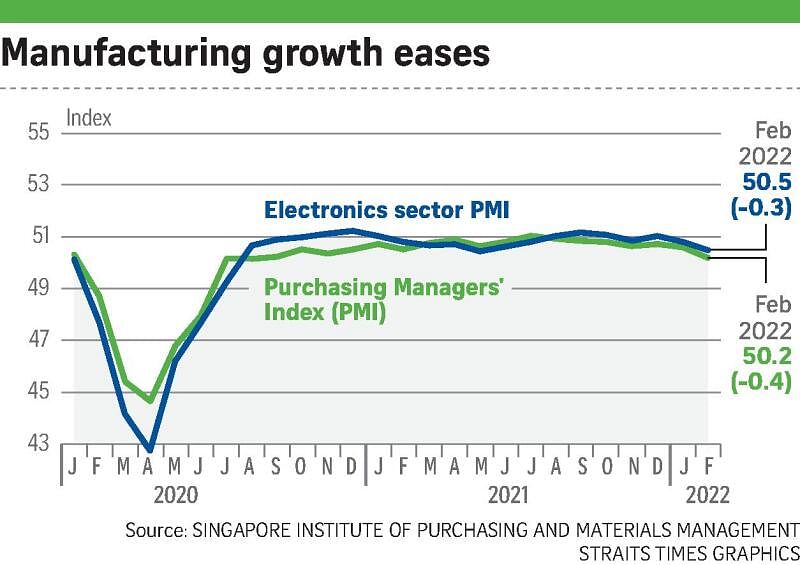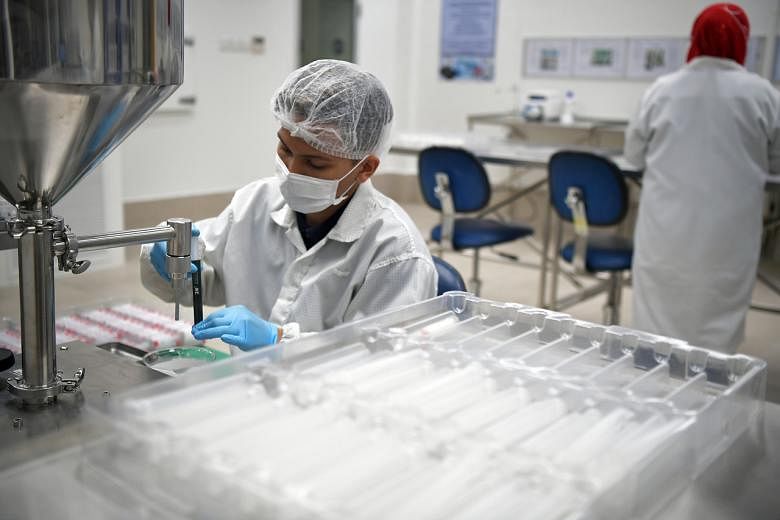SINGAPORE - Manufacturing activity expanded again in February - the 20th straight month of increase - but the pace of expansion continued to lose steam amid concerns over the Ukraine crisis.
The February reading of the Singapore purchasing managers' index (PMI) came in at 50.2, 0.4 point lower than January, noted the Singapore Institute of Purchasing and Materials Management (SIPMM) on Wednesday (March 2).
A reading above 50 indicates growth; one below 50 shows contraction.
The electronics sector PMI also posted a slower expansion at 50.5, a 0.3-point decrease from January but still the 19th consecutive month of growth for the sector.
Observers said there was a seasonal slowdown last month but warned that the manufacturing sector also faces headwinds from geopolitical uncertainties.
Ms Sophia Poh, SIPMM vice-president for industry engagement and development, said the lower readings were due to the Chinese New Year holidays and the shorter month of February.
"However, the Russia-Ukraine war has heightened concerns of greater cost pressures due to supply disruption, in addition to inflation. This has dampened the earlier cautious optimism of the manufacturing sector," she added.
SIPMM said February's overall PMI reading was due to slower growth in new orders, new exports, factory output and employment.
The inventory index contracted after posting 21 consecutive months of expansion.
Ms Selena Ling, head of treasury research and strategy at OCBC Bank, said this flags a slowing order book and a more cautious business sentiment.
The data also pointed to continuing increases in the price of raw materials, a trend that has been evident for many months.
Ms Ling said the sustained uptick reflects continued cost pressures, partly due to rising commodity prices and global supply chain bottlenecks.
She also noted that the electronics industry's output gauge has pulled back to 50 - compared with 50.4 in January - implying that electronics growth momentum could falter in the months ahead.
"The driver for this could be a combination of the ongoing chip shortage potentially exacerbated by the Russia-Ukraine conflict, which could impact Ukraine's neon exports," Ms Ling said.
Ukraine accounts for around 70 per cent of global exports of neon gas, used to power lasers that etch circuit patterns onto silicon wafers, according to research firm TrendForce.
UOB economist Barnabas Gan said the overall PMI reading saw the steepest decline since April 2020, when Singapore introduced a circuit breaker, but it nonetheless remained in expansion territory in line with the general improvement in the country's economic conditions.
The bank expects factory output growth to average 4 per cent in 2022, underpinned by buoyant global trade activity expected for the year ahead.
Mr Gan added that inflation risks remain. "The geopolitical tensions remain very fluid at this juncture, and any exacerbation could further elevate cost-push inflation."
Russia's invasion of Ukraine has fanned fears over commodity supplies in the resource-rich region, with Brent crude surging past US$110 a barrel on Wednesday.
OCBC's Ms Ling said the domestic manufacturing and electronics sectors are already tipped to moderate this quarter but geopolitical uncertainties mean there is now greater downside risk to this year's 3 per cent to 5 per cent growth forecast for Singapore's economy.



